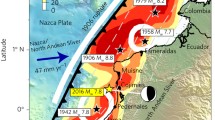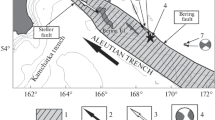Abstract
The Tehuantepec subduction zone was identified as a seismic gap by several authors. The presence of three large earthquakes at the turn of the twentieth century, in temporal and spatial proximity, poses questions on the extent of the seismic gap and on the type of tectonic deformation in this region. On 19 April 1902, a large earthquake occurred in Guatemala. The macroseismic data and recent relocations suggest that it is not a subduction event but an intraplate earthquake within the subducted Cocos plate. The recent relocations and the macroseismic data of the 23 September 1902 earthquake, which is frequently interpreted as an interplate subduction event, show that it is an intermediate-depth earthquake located inland in central Mexico. The 14 January 1903 earthquake, located in the Gulf of Tehuantepec, may be interpreted as an intraplate event, similar to the 8 September 2017 earthquake (Mw 8.2) or a subduction earthquake. Thus, there is no clear evidence of large subduction earthquakes (Mw > 7) in Tehuantepec at least in the last 250 years. Geodetic data suggest that the subduction zone is highly coupled and, therefore, a considerable amount of plate motion has not been released. The length of the presumed seismic gap is equivalent to a Mw ~ 8.5 earthquake. In contrast, the September 1902 (Mw 7.8), 1903 (Mw 7.4), 1931 (Mw 7.8), 1999 (Mw 7.5) and the great 8 September 2017 events (Mw 8.2) are all down-dip tensional earthquakes in the slab, reflecting a complex state of stress in the downgoing Cocos plate. These frequent and large tensional earthquakes may reflect a large-scale deformation of the slab that locked at the plate interface is under tensional stress under its own gravitational weight. As a result, seismic hazard in the Isthmus of Tehuantepec stems from both subduction and intraplate earthquakes.






Similar content being viewed by others
Data availability
The data from the Servicio Sismológico Nacional of Mexico (National Seismological Service) comes from http://www2.ssn.unam.mx:8080/catalogo/ (last consulted on 13 October 2020). The information from the International Seismological Centre is from the ISC online bulletin, https://doi.org/10.31905/D808B830 (last consulted on 13 October 2020). The macroseismic information of the 23 September 1902 earthquake may be consulted in http://sismoshistoricos.org/ (last consulted on 13 October 2020). Maps were drawn with GeoMapApp (https://www.geomapapp.org) last consulted on 13 October 2020.
References
Ambraseys NN (1995) Magnitudes of central American earthquakes 1898–1930. Geophys J Int 121(2):545–556
Ambraseys NN, Adams RD (1996) Large-magnitude central American earthquakes, 1898–1994. Geophys J Int 127(3):665–692
Anderson T (1908) The volcanoes of Guatemala. Geogr J 31:473–489
Bilek SL, Schwartz SY, DeShon HR (2003) Control of seafloor roughness on earthquake rupture behavior. Geology 31(5):455–458
Böse E (1903) Informe sobre los temblores de Zanatepec a fines de Septiembre de 1902 y sobre el estado actual del volcán de Tacana. Parergones del Instituto geológico de Mexico 1(1):20
Chael EP, Stewart GS (1982) Recent large earthquakes along the Middle American trench and their implications for the subduction process. J Geophys Res Solid Earth 87(B1):329–338
Christensen DH, Lay T (1988) Large earthquakes in the Tonga region associated with subduction of the Louisville Ridge. J Geophys Res Solid Earth 93(B11):13367–13389
Duda S (1965) Secular seismic energy release in the circum-Pacific belt. Tectonophysics 2:409–452
Eisen G (1903) The earthquake and volcanic eruption in Guatemala in 1902. Bull Am Geogr Soc 35(4):325–352
Engdahl ER, Villaseñor A (2002) Centennial earthquake catalog. In: Lee WHK, Kanamori H, Jennings PC, Kisslinger C (eds) International handbook of earthquake and engineering seismology, part A, chapter 41, international geophysics series, vol 81A. Academic, London, pp 665–690
Franco A, Lasserre C, Lyon-Caen H, Kostoglodov V, Molina E, Guzman-Speziale M, Barrier E (2012) Fault kinematics in northern Central America and coupling along the subduction interface of the Cocos plate, from GPS data in Chiapas (Mexico), Guatemala and El Salvador. Geophys J Int 189(3):1223–1236
Galvan Rivera M (1950) Colección de las Efemérides Publicadas en el Calendario del mas Antiguo Galván; desde su Fundación hasta el 30 Junio de 1950. Antigua Librería de Murguía, México, 848 pp
García-AcostaV, Suárez G (1996) Los sismos en la historia de México, tomo I. Universidad Nacional Autónoma de México/Centro de Investigaciones y Estudios Superiores en Antropología Social/Fondo de Cultura Económica, pp 719
Graindorge D, Calahorrano A, Charvis P, Collot JY, Bethoux N (2004) Deep structures of the Ecuador convergent margin and the Carnegie Ridge, possible consequence on great earthquakes recurrence interval. Geophys Res Lett 31:L04603. https://doi.org/10.1029/2003GL018803
Gutenberg B (1956) Great earthquakes 1896-1903. Trans Am Geophys Union 37:608–614
Kelleher J, McCann W (1976) Buoyant zones, great earthquakes, and unstable boundaries of subduction. J Geophys Res 81(26):4885–4896
Kelleher J, Sykes L, Oliver J (1973) Possible criteria for predicting earthquake locations and their application to major plate boundaries of the Pacific and the Caribbean. J Geophys Res 78(14):2547–2585
Kodaira S, Nakanishi A, Park JO, Ito A, Tsuru T, Kaneda Y (2003) Cyclic ridge subduction at an inter‐plate locked zone off central Japan. Geophys Res Lett 30(6):1339. https://doi.org/10.1029/2002GL016595
Kostoglodov V, Pacheco JF (1999) Cien años de sismicidad en México. Instituto de Geofísica, Universidad Nacional Autónoma de México, Mexico (map)
List K (1903) Erdbeben an der Küste Guatemalas im Jahre 1902 und deren Folgeerscheinungen. Ann Hydrograph Marit Meteorolog 52-4 und Beilag.: ii-iv, Hamburg
Mandujano-Velazquez JJ, Keppie JD (2009) Middle Miocene Chiapas fold and thrust belt of Mexico: a result of collision of the Tehuantepec transform/ridge with the Middle America Trench. Geol Soc Lond, Spec Publ 327(1):55–69
Manea M, Manea VC, Ferrari L, Kostoglodov V, Bandy WL (2005) Tectonic evolution of the Tehuantepec Ridge. Earth Planet Sci Lett 238(1–2):64–77
McCann WR, Nishenko SP, Sykes LR, Krause J (1979) Seismic gaps and plate tectonics: seismic potential for major boundaries. In: Earthquake prediction and seismicity patterns. Birkhäuser, Basel, pp 1,082–1,147
Melgar D, Ruiz-Angulo A, Garcia ES, Manea M, Manea VC, Xu X et al (2018) Deep embrittlement and complete rupture of the lithosphere during the M w 8.2 Tehuantepec earthquake. Nat Geosci 11(12):955–960
Métois M, Socquet A, Vigny C (2012) Interseismic coupling, segmentation and mechanical behavior of the central Chile subduction zone. J Geophys Res Solid Earth 117(B3)
Miranda Marrón M (1908) Las catástrofes de 1906. Estudio presentado y dedicado a la Sociedad Mexicana de Geografía y Estadística. Imprenta y Fototipia de la Secretaría de Fomento, México
Muñoz Lumbier M (1918) La seismología en México hasta 1917. Instituto Geológico de México, Boletín 36, 102 pp
Nishenko SP (1991) Circum-Pacific seismic potential: 1989–1999. In: Aspects of Pacific seismicity. Birkhäuser, Basel, pp 169–259
Nishenko SP, Singh SK (1987) Relocation of the great Mexican earthquake of 14 January 1903. Bull Seismol Soc Am 77(1):256–259
Oldham RD (1905) The rate of transmission of the Guatemala earthquake, April 19, 1902. Proceedings of the Royal Society 578 of London Series A, Containing Papers of a Mathematical 579 and Physical Character. Proc R Soc Lond 76(508):102–111
Pacheco JF, Sykes LR (1992) Seismic moment catalog of large shallow earthquakes, 1900 to 1989. Bull Seismol Soc Am 82(3):1306–1349
Pardo M, Suárez G (1995) Shape of the subducted Rivera and Cocos plates in southern Mexico: seismic and tectonic implications. J Geophys Res Solid Earth 100(B7):12357–12373
Park JO, Moore GF, Tsuru T, Kodaira S, Kaneda Y (2004) A subducted oceanic ridge influencing the Nankai megathrust earthquake rupture. Earth Planet Sci Lett 217(1–2):77–84
Rebollar CJ, Quintanar L, Yamamoto J, Uribe A (1999) Source process of the Chiapas, Mexico, intermediate-depth earthquake (Mw= 7.2) of 21 October 1995. Bull Seismol Soc Am 89(2):348–358
Rockstroh E (1902) Earthquake in Guatemala. Nature 66:150
Rockstroh E (1903) Recent earthquakes in Guatemala. Nature 67:271–272
Scholz CH, Small C (1997) The effect of seamount subduction on seismic coupling. Geology 25(6):487–490
Singh SK, Astiz L, Havskov J (1981) Seismic gaps and recurrence periods of large earthquakes along the Mexican subduction zone: a reexamination. Bull Seismol Soc Am 71(3):827–843
Singh SK, Suárez G, Domínguez T (1985) The Oaxaca, Mexico, earthquake of 1931: lithospheric normal faulting in the subducted Cocos plate. Nature 317(6032):56–58
Singh SK, Ordaz M, Alcántara L, Shapiro N, Kostoglodov V, Pacheco JF et al (2000) The Oaxaca earthquake of 30 September 1999 (Mw= 7.5): a normal-faulting event in the subducted Cocos plate. Seismol Res Lett 71(1):67–78
Storchak DA, Di Giacomo D, Bondár I, Engdahl ER, Harris J, Lee WH, K., Villaseñor A., and Bormann P. (2013) Public release of the ISC–GEM global instrumental earthquake catalogue (1900–2009). Seismol Res Lett 84(5):810–815. https://doi.org/10.1785/0220130034
Storchak DA, Di Giacomo D, Engdahl ER, Harris J, Bondár I, Lee WHK, Bormann P, Villaseñor A (2015) The ISC-GEM global instrumental earthquake catalogue (1900-2009): introduction. Phys Earth Planet Inter 239:48–63. https://doi.org/10.1016/j.pepi.2014.06.009
Suárez G (2000) Reverse faulting in the Isthmus of Tehuantepec: Backarc deformation induced by the subduction of the Tehuantepec ridge. In: Delgado H, Aguirre G, Stock J (eds) Special Papers-Geological Society of America 334: 263–268. https://doi.org/10.1130/0-8137-2334-5.263
Suárez G, Albini P (2009) Evidence for great tsunamigenic earthquakes (M 8.6) along the Mexican subduction zone. Bull Seismol Soc Am 99(2A):892–896
Suárez G, López A (2015) Seismicity in the southwestern Gulf of Mexico: evidence of active back arc deformation. Revista Mexicana de Ciencias Geológicas 32(1):77–83
Suárez G, Santoyo MA, Hjorleifsdottir V, Iglesias A, Villafuerte C, Cruz-Atienza VM (2019) Large scale lithospheric detachment of the downgoing Cocos plate: the 8 September 2017 earthquake (mw 8.2). Earth Planet Sci Lett 509:9–14
Suárez G, Ruiz-Barón D, Chico-Hernández C, Zúñiga FR (2020) Catalog of preinstrumental earthquakes in central Mexico: epicentral and magnitude estimations based on macroseismic data. Bull Seismol Soc Am. https://doi.org/10.1785/0120200127
Wang K, Bilek SL (2011) Do subducting seamounts generate or stop large earthquakes? Geology 39(9):819–822
Wood HO, Neumann F (1931) Modified Mercalli Intensity scale of 1931. Bull Seismol Soc Am 21(4):277–283
Ye L, Lay T, Bai Y, Cheung KF, Kanamori H (2017) The 2017 Mw 8.2 Chiapas, Mexico earthquake: energe tic slab detachment. Geophys Res Lett 44(23):11–824
Acknowledgments
This work was done thanks to the support of the Instituto de Geofísica at the Universidad Nacional Autónoma de México. I thank C. Villafuerte for digitized contours of the subducted Cocos plate. The comments and suggestions made by L. Quintanar and A. Husker on an early version helped to broaden the scope of the manuscript. The comments and suggestions made by the Associate Editor Mariano García Fernández and an anonymous reviewer substantially improved the manuscript.
Author information
Authors and Affiliations
Corresponding author
Ethics declarations
Conflict of interest
The authors declare that they have no conflicts of interest. The data is available from the published articles and seismological catalogs listed.
Additional information
Publisher’s note
Springer Nature remains neutral with regard to jurisdictional claims in published maps and institutional affiliations.
Highlights
• Large subduction earthquakes have not occurred in the Isthmus of Tehuantepec in the last 250 years.
• All recent large earthquakes in the Isthmus of Tehuantepec are tensional events within the downgoing Cocos plate.
• Seismic and tsunami hazards in Tehuantepec stem from both subduction and tensional earthquakes in the slab.
Rights and permissions
About this article
Cite this article
Suárez, G. Large earthquakes in the Tehuantepec subduction zone: evidence of a locked plate interface and large-scale deformation of the slab. J Seismol 25, 449–460 (2021). https://doi.org/10.1007/s10950-020-09969-6
Received:
Accepted:
Published:
Issue Date:
DOI: https://doi.org/10.1007/s10950-020-09969-6




